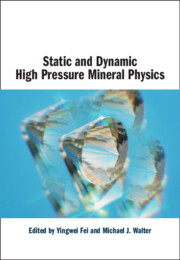Book contents
- Static and Dynamic High Pressure Mineral Physics
- Static and Dynamic High Pressure Mineral Physics
- Copyright page
- Contents
- Contributors
- 1 Introduction to Static and Dynamic High-Pressure Mineral Physics
- 2 Development of Static High-Pressure Techniques and the Study of the Earth’s Deep Interior in the Last 50 Years and Its Future
- 3 Applications of Synchrotron and FEL X-Rays in High-Pressure Research
- 4 Development of Large-Volume Diamond Anvil Cell for Neutron Diffraction: The Neutron Diamond Anvil Cell Project at ORNL
- 5 Light-Source Diffraction Studies of Planetary Materials under Dynamic Loading
- 6 New Analysis of Shock-Compression Data for Selected Silicates
- 7 Scaling Relations for Combined Static and Dynamic High-Pressure Experiments
- 8 Equations of State of Selected Solids for High-Pressure Research and Planetary Interior Density Models
- 9 Elasticity at High Pressure with Implication for the Earth’s Inner Core
- 10 Multigrain Crystallography at Megabar Pressures
- 11 Deformation and Plasticity of Materials under Extreme Conditions
- 12 Synthesis of High-Pressure Silicate Polymorphs Using Multi-Anvil Press
- 13 Investigation of Chemical Interaction and Melting Using Laser-Heated Diamond Anvil Cell
- 14 Molecular Compounds under Extreme Conditions
- 15 Superconductivity at High Pressure
- 16 Thermochemistry of High-Pressure Phases
- Index
- References
15 - Superconductivity at High Pressure
Published online by Cambridge University Press: 03 August 2023
- Static and Dynamic High Pressure Mineral Physics
- Static and Dynamic High Pressure Mineral Physics
- Copyright page
- Contents
- Contributors
- 1 Introduction to Static and Dynamic High-Pressure Mineral Physics
- 2 Development of Static High-Pressure Techniques and the Study of the Earth’s Deep Interior in the Last 50 Years and Its Future
- 3 Applications of Synchrotron and FEL X-Rays in High-Pressure Research
- 4 Development of Large-Volume Diamond Anvil Cell for Neutron Diffraction: The Neutron Diamond Anvil Cell Project at ORNL
- 5 Light-Source Diffraction Studies of Planetary Materials under Dynamic Loading
- 6 New Analysis of Shock-Compression Data for Selected Silicates
- 7 Scaling Relations for Combined Static and Dynamic High-Pressure Experiments
- 8 Equations of State of Selected Solids for High-Pressure Research and Planetary Interior Density Models
- 9 Elasticity at High Pressure with Implication for the Earth’s Inner Core
- 10 Multigrain Crystallography at Megabar Pressures
- 11 Deformation and Plasticity of Materials under Extreme Conditions
- 12 Synthesis of High-Pressure Silicate Polymorphs Using Multi-Anvil Press
- 13 Investigation of Chemical Interaction and Melting Using Laser-Heated Diamond Anvil Cell
- 14 Molecular Compounds under Extreme Conditions
- 15 Superconductivity at High Pressure
- 16 Thermochemistry of High-Pressure Phases
- Index
- References
Summary
Room temperature superconductivity (RTSC) is one the most challenging and longstanding problems in solid-state physics. The Bardeen–Cooper–Schrieffer (BCS) theory (1956) explained superconductivity but could not predict high critical temperatures (Tc). Extension of the BCS theory allowed RTSC in principle; however, estimations for realistic materials gave low Tc, with the only exception being metallic hydrogen. Therefore, conventional superconductors were not considered potential RTSCs. This tendency strengthened after the experimental discovery of superconductivity in cuprates with very high Tc, up to 133 K. Later, other families of nonconventional superconductivity appeared, notably, iron-based superconductors with Tc reaching 100 K. However, the mechanism of superconductivity in these materials is still not understood, and there has been no progress for many years in increasing Tc. Unexpectedly, conventional superconductors recently showed a clear prospect to be the first RTSCs: Tc = 203 K was discovered in H3S, and then Tc = 250 K in LaH10. This breakthrough resulted from a combination of factors, including the general idea to consider hydrogen-dominant materials, the appearance of ab initio predictions of structures for searching new materials, and advances in synthesis and characterization of new superconductors at megabar pressures. There is a clear prospect to achieve higher Tc in other binary or ternary hydrides. At ambient pressures, there is also a distinct possibility for substantial superconductivity, likely in materials with strong covalent bonding.
- Type
- Chapter
- Information
- Static and Dynamic High Pressure Mineral Physics , pp. 368 - 386Publisher: Cambridge University PressPrint publication year: 2022



